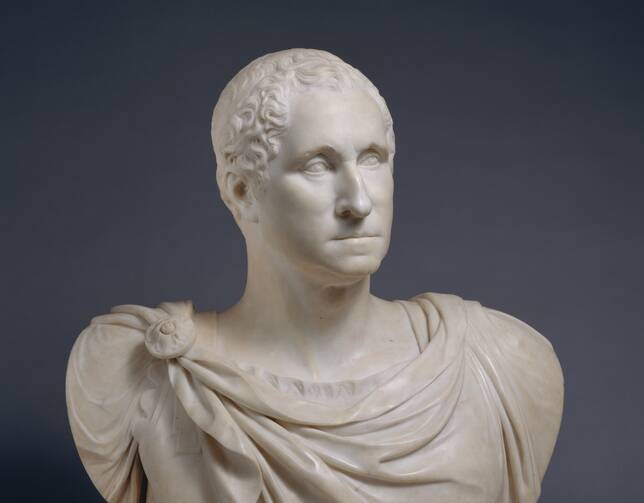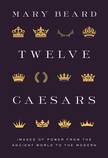Review: It’s good to be king. It’s better to be Caesar.
The prolific classicist Mary Beard, a professor at the University of Cambridge, has written books on Pompeii, the history of Rome, the Colosseum and the Roman triumph, among many other books and academic articles. She also engages with popular perceptions of the classical world through her blog, published by The Times Literary Supplement, and her popular Twitter account. In Twelve Caesars: Images of Power From the Ancient World to the Modern, an engaging, erudite and enormously informative book, she analyzes the reception and adaptation of ancient Roman imperial portraits in Western European and American art from the 15th century to the present.
Her topic is relevant to anyone who has wondered why a statue of Benjamin Franklin by Francesco Lazzarini—commissioned in 1789 for the Library Company of Philadelphia— shows him clad in a toga. And why in September 2021, just as Beard’s book was published, the equestrian statue of the Confederate general Robert E. Lee was removed from its base on Monument Avenue in Richmond, Va.
Mary Beard’s fascinating book asks its readers to be curious about, and critical of, redeployments of the images of Roman emperors from the Renaissance in Italy to 20th-century America.
The idiom of the bronze equestrian statue perhaps seems generically triumphal to contemporary American viewers, but it is as reminiscent of ancient Rome as the toga. This artistic style descends from famous surviving antecedents like the second-century bronze equestrian statue of the emperor Marcus Aurelius that was mistakenly believed in the Renaissance to depict the fourth-century Christian emperor Constantine. (Though Beard does not discuss this example, misidentifications of imperial portraits are a major theme of her book.)
Beard’s fascinating book asks its readers to be curious about, and critical of, redeployments of the images of Roman emperors from the Renaissance in Italy to 20th-century America. What choices do artists and patrons make? How might ancient Roman imperial portraits be received (and misunderstood) by later audiences? What do images of Roman emperors tell us about the later cultures in which they were reproduced?
The opening vignette of the book presents a marble sarcophagus, allegedly used for the burial of the emperor Alexander Severus, who ruled in 222-235 A.D. It was discovered in Lebanon in 1837 and brought to the United States by Jesse Elliott, an American navy commander. Elliott donated it to the nation in 1845 and hoped that Andrew Jackson might choose to be buried in it. Jackson declined vehemently, writing that as a patriotic American and lover of republican values, he did not want an imperial burial.
Beard illustrates the story with a photograph of two visitors at the sarcophagus in 1965 reading a label about Andrew Jackson’s refusal. Beard makes quick work of this legend: Not only did the marble sarcophagus not belong to Alexander Severus (who was probably buried in Rome, not in Lebanon); there is no indication that the sarcophagus belonged to any Roman emperor. But those facts matter less than the role that the ancient Roman “imperial” sarcophagus served in fashioning American presidential identity in the 19th century, and as a reminder of the strength of American democracy for visitors to the National Mall in the 20th century.
Beard’s book is full of these evocative and occasionally startling examples (among them, an ancient marble head of Julius Caesar dredged from the bed of the Hudson River in 1925). The chapters can stand alone, as they cover discrete topics such as “Coins and Portraits,” “The Twelve Caesars” (on sets of images of emperors, such as the silver gilt dishes known as the Aldobrandini Tazze) and “The Most Famous Caesars of Them All” (on Titian’s 16th-century paintings of Roman emperors displayed in Mantua, Italy). This division and the focus on images reflect the book’s origin in the A. W. Mellon Lectures in the Fine Arts that Beard delivered at the National Gallery in London in 2011; Twelve Caesars is an updated and expanded version of the lecture material.
Beard’s analysis ranges confidently across media—paintings, sculpture, tapestry, coins—and eras, with most of the analysis focusing on the 15th through 17th centuries.
After this first group of chapters, Beard shifts to analysis of those reuses of Roman imperial iconography that were not necessarily positive. These include tapestries created for Henry VIII that seem ambivalent about royal power (whether or not the royal patrons were aware of it), as well as portraits that convey lessons about imperial vices. Beard also devotes a chapter to portraits of imperial women, showing how they were used historically: For example, images of Agrippina, wife of Germanicus, served in the history of art as an exemplar of familial devotion and loyalty, in contrast to those of the younger imperial Agrippina, mother of the infamous emperor Nero. The author also presents a gory medieval manuscript painting of Nero calmly observing his mother’s dissection in order to see her womb, no better representation of anxiety about maternal power.
It is hard to imagine anyone other than Beard writing this book. Her granular knowledge of ancient Roman history, literature and art, bridged with an encyclopedic understanding of the visual culture of neoclassicism in art, creates a book of great interest to scholars, students and a general audience. Beard’s analysis ranges confidently across media—paintings, sculpture, tapestry, coins—and eras, with most of the analysis focusing on the 15th through 17th centuries.
Her analysis is insightful and groundbreaking. She reattributes a silver gilt dish at the Victoria and Albert Museum that was associated with Domitian, noting that the scenes shown on part of the dish come from the life of Tiberius. Beard also points out that the generic “scenes from the life of Julius Caesar” depicted on tapestries made for Henry VIII are actually illustrations of “Pharsalia,” the epic poem by the first-century poet Lucan.
A caveat related to the ambitious range of material is that the chapters can overwhelm the reader with their level of detail. Beard is both comprehensive and precise, with the result that some sections of this book (especially those describing reconstructions of lost monuments) require sustained concentration (and rereading) in order to follow.
Beard ends her book with a photograph of the current milieu of the Roman “imperial” sarcophagus that Jackson declined to use for his tomb. It lies in the Smithsonian’s storage in Maryland, obscure again after its brief moment in the sun as a symbol of American democracy.
This article also appeared in print, under the headline “Appropriating Imperial Power,” in the April 2022, issue.











